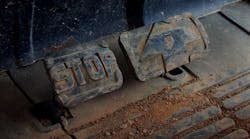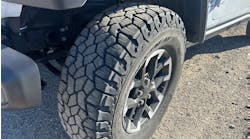It’s no secret that reducing the speed of a medium duty commercial vehicle, or bringing it to a complete stop , requires both a tremendous amount of force and functioning brakes that are up to the task.
Fleets need to be aware of the different types of vehicle brakes found on medium duty vehicles. They also need to be assured that they own vehicles that are equipped with the most appropriate brakes for the applications in which they are used. That way, they can ensure maintenance costs are kept down and the vehicles stay out of the shop and on the road.
“In general, both disc and drum brakes work in most applications,” says Nicole Oreskovic, product director, air disc brake, Bendix Spicer Foundation Brake a designer and manufacturer of brake components, hydraulic brake and friction components, actuation systems and medium and heavy duty aftermarket parts for medium and heavy duty commercial vehicles (www.foundationbrakes.com).
“The decision of air disc versus drum brakes typically comes down to a total cost of ownership decision,” Oreskovic adds.
According to Joey Campbell, manager, engineering, air disc brake, Bendix Spicer Foundation Brake, there are both some distinct similarities and notable differences between the types of medium duty brakes found on commercial vehicles today:
Air Disc Brakes
Air is supplied from the vehicle’s braking system to the individual wheel ends, where an air chamber or actuator is employed to translate the air pressure into a mechanical force. That force is then applied to the disc brake, which amplifies the force and clamps two pads onto the rotor to slow a vehicle’s speed.
Drum Brakes
Force applied to the drum brake is created by an air chamber, as with an air disc brake. However, with a drum brake, the air chamber applies the mechanical force to a slack adjustor, which promptly creates a torque that is applied to the S-cam. When that S-cam rotates, the brake linings are pressed against the interior of the wheel hub to slow the vehicle.
Disc/Drum Hydraulic Brakes
Hydraulic fluid is utilized instead of air to apply pressure. Because fluid can handle higher pressure, hydraulics typically apply a force directly to a disc or a drum brake. For example, hydraulic pressure is employed to push disc brake pads against the rotor. There is no fluid equivalent of an actuator.
DISC VERSUS DRUM
Drum brakes are commonly found on medium duty vehicles because they are less expensive than their counterparts, and because it is easier to incorporate a parking brake into a drum, states Steve Ruiz, vice president of engineering, research and development, Centric Parts, a provider of aftermarket brake systems and replacement parts (www.centricparts.com).
However, says Bendix’s Oreskovic, more and more fleets are employing vehicles equipped with air disc brakes for a variety of reasons.
“Air disc brakes provide better performance in that a more consistent torque is generated and vehicles are typically able to stop quicker,” she says. “Air disc brakes also offer the advantages of quicker pad replacement and longer brake lining life, which means greater uptime and lower maintenance costs.”
Fleets are also finding that they provide a car-like feel and straighter, more stable stops.
“Additionally, air disc brakes include an internal self-adjustment mechanism that can help lower the risk of brakes being found out of adjustment during inspection, which can affect Compliance, Safety, Accountability (CSA) scoring,” adds Oreskovic.
CSA is a Federal Motor Carrier Safety Administration safety compliance and enforcement program. It utilizes commercial vehicle inspections and crash results to assess the safety performance of motor carriers.
“Disc brake components are generally lighter and much more efficient in operation, allowing better braking performance, greater modulation and superior heat dissipation over drum systems,” adds Ruiz of Centric Parts.
MAINTENANCE CONSIDERATIONS
Proper preventive maintenance is critical to fleets being able to get the most out of their braking systems and components. Fleets must make an effort to check brake pad thickness based on vehicle use, during maintenance intervals, as well as within the context of applicable local laws and regulations.
Corrosion and buildup of debris on braking systems is always a concern for fleets, so maintenance professionals must be sure to change the pad and caliper-mounting hardware, as well as lubricate any pins or slides appropriately with high-temperature brake grease during the process of changing pads, recommend brake manufacturers
Furthermore, rotors should be inspected and checked with a micrometer to ensure they are in spec, they add. When necessary, rotors should be replaced. Also, fleets should always inspect the condition of brake hoses and other components to determine whether or not they should be replaced.
“Burned, glazed or oil-contaminated brake pads must be replaced immediately,” say officials at WABCO, a global supplier of technologies and services that improve the safety, efficiency and connectivity of commercial vehicles (www.wabco-auto.com). “Always replace all brake pads by axle, using a new retaining system for brake pads and pressure plates. To avoid damaging the brake disc, replace the brake pads no later than at the point when they reach the wear limit at their weakest spot. The residual pad thickness must not be allowed to become less than 2mm above the backing.”
WABCO officials also advise doing the following when conducting an inspection with the wheel removed from the vehicle:
● Check boots, seals and end caps for damage or cracks.
● Measure pad wear.
● Inspect the rotors for cracks.
● Check running clearances and adjuster operation.
● Check caliper side movement. It should move easily by hand.
● Check caliper guiding clearances.
● Inspect all caps, hoses and the entirety of the brake’s exterior for damage.
When it comes to disc brakes, says Bendix’s Oreskovic, fleets need to ensure pad and rotor thicknesses are checked regularly. Furthermore, the vast majority of disc brakes employ a floating caliper.
“That means the caliper moves on pins as brakes are applied, and it needs to be checked in order to prevent uneven pad wear,” she continues.
For drum brakes, the lining and drums should be inspected on a regular basis for signs of thickness or signs of friction issues, in addition to regular grease maintenance of the slack adjuster and S-cam.
“Brake stroke should also be measured regularly to ensure brakes are not out of adjustment,” Oreskovic adds.
SPEC’ING CONSIDERATIONS
Very few OEMs offer multiple brake spec options for the medium duty segment, though some are promoting disc brakes in an effort to aid in widespread fleet acceptance.
According to WABCO officials, air disc brake segments of the industry with the largest growth potential are the following:
● Dry van operations.
● Tank fleets.
● Waste hauling.
● Bus fleets.
● Hazardous material hauling.
“These applications typically call for high-brake usage and ‘stop-and-go’ conditions and take full advantage of the lower brake temperatures and longer life offered by the air disc brakes, compared to drum brakes,” they add.
AWARENESS AND UNDERSTANDING
There is no overstating the importance for fleets to have a strong understanding of modern brake technology to ensure they are getting the most out of their investments in the vehicles that employ them, as well as to determine whether or not they are being efficiently and effectively maintained. While drum brakes are still found on a significant percentage of medium duty commercial vehicles, the ever-increasing prevalence of disc braking systems appears to be a trend that is here to stay.
“Drums are primarily still used for their lower cost, but they have largely been replaced by four-wheel disc systems in modern vehicles,” says Ruiz of Centric Parts. “There really are few advantages to the older drum brake systems. They are much more prone to fade, are heavier and take longer to service. Disc systems are generally preferred because of their better overall performance.”




